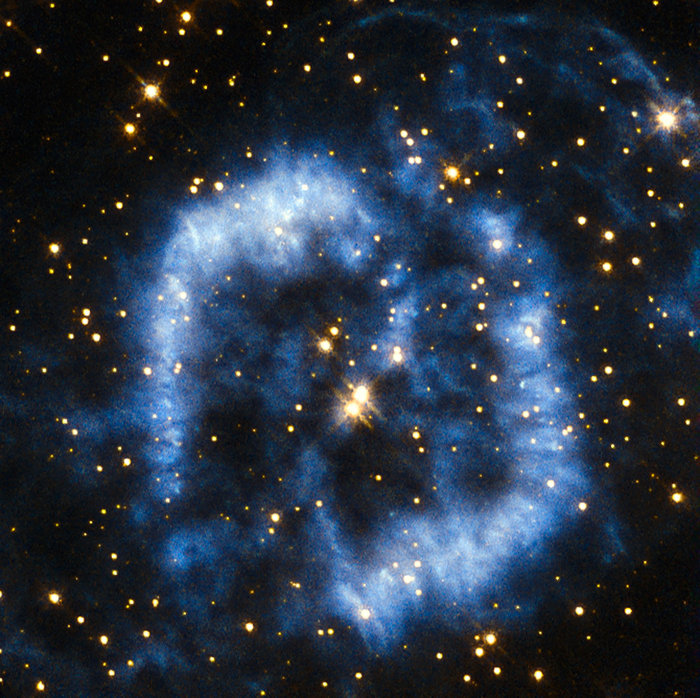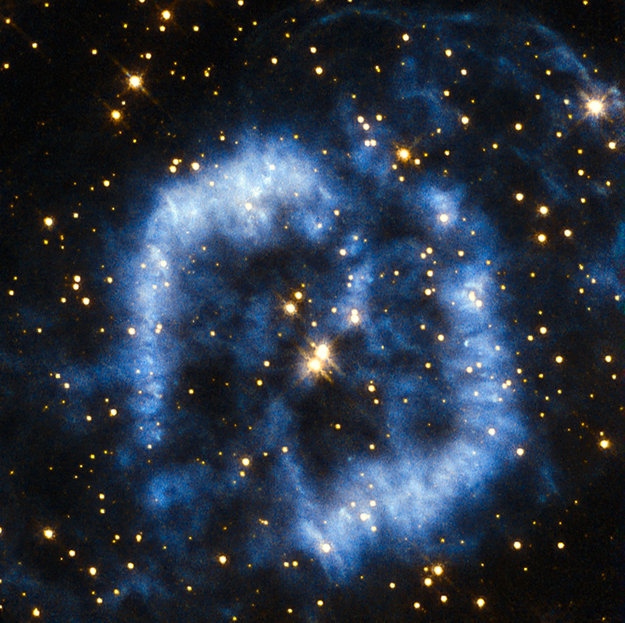
- Title Hubble pictures planetary nebula with spiral arms
- Released 10/10/2016 1:01 pm
- Copyright ESA/Hubble & NASA; Acknowledgement: Serge Meunier
- DescriptionThe two spiral arms winding towards the bright centre might deceive you into thinking you are looking at a galaxy a bit like our Milky Way. But the object starring in this image is of a different nature: PK 329-02.2 is a ‘planetary nebula’ within our home galaxy.Despite the name, this isn’t a planet either. Planetary nebula is a misnomer that came about because of how much nebulas resembled giant, gaseous planets when looked through a telescope in the 1700s. Rather, what we see in this image is the last breath of a dying star.When stars like the Sun are nearing the end of their lives, they let go of their gaseous outermost layers. As these clouds of stellar material move away from the central star they can acquire irregular and complex shapes. This complexity is evident in the faint scattered gas you see at the centre of the image. But there is also beautiful symmetry in PK 329-02.2, as the two bright blue spiral arms perfectly align with the two stars at the centre of the nebula.It may look like the spiral arms are connected, but it is the stars that are companions. They are part of a visual binary, though only the one at the upper right gave rise to the nebula. While the stars will continue to orbit each other for millions or billions of years, the nebula – and its spiral arms – will spread out from the centre and eventually fade away over the next few thousands of years.This planetary nebula with spiral arms is also known as Menzel 2, after the US astronomer Donald Menzel who discovered it in the 1920s. It is located in Norma, a constellation in the Southern celestial hemisphere where you can also find Menzel 1 and 3, two ‘bipolar planetary nebulas’ (shaped like butterflies or hourglasses).Hubble’s Wide Field and Planetary Camera 2 captured this image, which was processed using green, blue, red and infrared filters. Astrophotography-enthusiast Serge Meunier entered a version of this image into the 2012 Hubble’s Hidden Treasures image processing competition.
- Id 366634
Una nebulosa planetaria con brazos espirales
http://www.esa.int/esl/ESA_in_your_country/Spain/Una_nebulosa_planetaria_con_brazos_espirales
11 octubre 2016
Los dos brazos espirales que giran hacia el centro de la imagen podrían hacernos creer erróneamente que estamos viendo una galaxia similar a nuestra Vía Láctea.
En cambio, nos encontramos ante un objeto de otro tipo: PK 329-02.2 es una ‘nebulosa planetaria’ en el interior de nuestra galaxia.
A pesar de su nombre, tampoco se trata de un planeta. La engañosa denominación de nebulosa planetaria se debe a que, vistas a través de los telescopios del siglo XVIII, estas nebulosas parecían gigantescos planetas gaseosos. Pero lo que nos muestra esta imagen es el último aliento de una estrella moribunda.
Cuando estrellas como nuestro Sol se acercan al final de su vida, dejan escapar al espacio sus capas externas de gas. A medida que estas nubes de materia estelar se alejan de la estrella central, pueden dibujar complejas formas irregulares como las que forma el gas dispersado por el centro de esta imagen. Además, PK 329-02.2 presenta una bella simetría, ya que sus dos brillantes brazos espirales están perfectamente alineados con las dos estrellas situadas en el centro de la nebulosa.
Podría parecer que los brazos se encuentran conectados, pero no: son las estrellas quienes son compañeras. Forman parte de un sistema binario, aunque solo la que vemos arriba y a la derecha dio lugar a la nebulosa. Mientras las estrellas continúan orbitándose mutuamente durante millones y millones de años, la nebulosa y sus brazos en espiral irán alejándose del centro hasta desvanecerse en pocos miles de años.
Esta nebulosa planetaria con brazos espirales también se conoce como Menzel 2, en honor al astrónomo estadounidense Donald Menzel, que la descubrió en los años veinte del siglo XX. Se encuentra en Norma, una constelación en el hemisferio celeste sur, donde también se encuentran Menzel 1 y Menzel 3, dos ‘nebulosas planetarias bipolares’ (es decir, en forma de mariposa o reloj de arena).
La Cámara Planetaria y de Gran Angular 2 de Hubble capturó esta imagen, que se ha procesado con filtros verde, azul, rojo y de infrarrojos. El astrofotógrafo Serge Meunier participó con una versión de ella en el concurso de procesamiento de imágenes Tesoros ocultos del Hubble en 2012.
ESAGuillermo Gonzalo Sánchez Achutegui
ayabaca@gmail.com
ayabaca@hotmail.com
ayabaca@yahoo.com
Inscríbete en el Foro del blog y participa : A Vuelo De Un Quinde - El Foro!


No hay comentarios:
Publicar un comentario